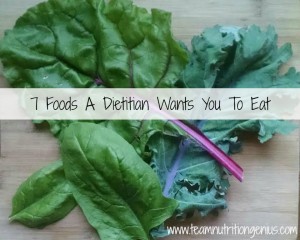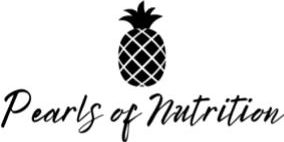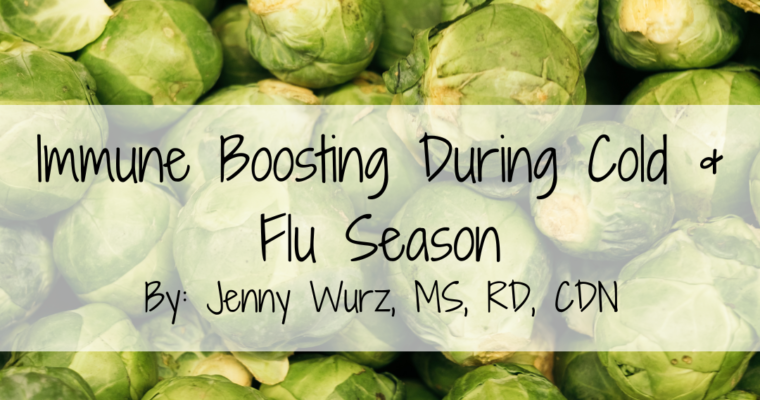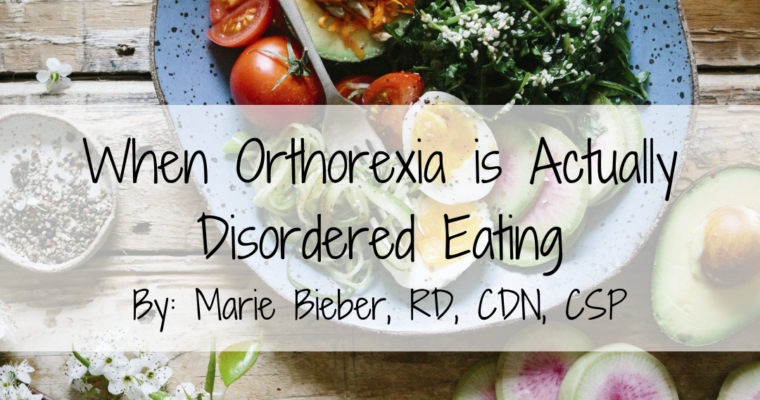
Don’t eat pasta, avoid all the IPAs, stop going out for fast food. WAHHH WAHHH WAHHHH who wants to hear about all the food you can’t have?! Not this gal. It’s always better to focus on what you can and should add to your diet and eventually all the good will crowd out the bad. Here it is friends, 7 foods a dietitian wants you to eat.
Dark Leafy Greens
Dark leafy greens are some of our most nutrient-dense foods meaning they have a TON of vitamins and minerals for very little calories. They are packed with vitamins A, C, and K, and contain smaller amounts of our B vitamins and vitamin E. They are also a great non-dairy source of calcium and contain appreciable amounts of manganese, choline, iron, copper, and magnesium. Not only are they full of micronutrients they also contain phytonutrients like carotenoids and phenolics. These phytonutrients work as antioxidants in our body fighting off free radicals and the damage they cause which can lead to a whole host of chronic diseases including cancer, cardiovascular disease, autoimmune conditions like rheumatoid arthritis and neurodegenerative diseases like Alzheimer’s to name a few. I honestly don’t care what kind you are eating as long as you’re eating them. Some options are mustard, turnip, collard, dandelion and beet greens, kale, swiss chard, bok choy, cabbage, spinach, arugula, and watercress. Broccoli and Brussels sprouts even count Cooking is as easy as sautéing these guys with butter, salt, and pepper and finish with lemon juice.
Liver
Eating liver is basically like eating a whole food version of a multivitamin because one of the liver’s many functions is nutrient storage. A 3 oz serving of beef liver gives you more than your daily needs of vitamin A, vitamin B12, riboflavin, and copper and is also a great source of niacin, thiamin, vitamin B6, folate, pantothenic acid, iron, phosphorus, zinc, manganese, and selenium. It’s far more nutrient dense than the muscle meat we typically eat. Even if you aren’t ready to dive headfirst into liver and onions you can always blenderize liver and add it to meatballs, meatloaf, burgers, or Sassy’s Bacon Wrapped Meatloaf Muffins. (Try the meatloaf muffins, they are contest winning!)
Fatty Fish
Fatty fish including anchovies, salmon, mackerel, whitefish, sardines, tuna, herring, and trout are high in omega-3 fatty acids. Omega-3 fatty acids are an essential fatty acid meaning the body is unable to make it and it is therefore essential we obtain it from our food. We need omega-3s for our brain development and function and they are precursors for anti-inflammatory compounds in our body. To learn more about the dreaded inflammation check out Nutrition Genius Radio Episode #30. The average American consumes less than half of the recommended dose of the omega-3 fatty acids EPA and DHA. To make sure you’re getting enough of this good stuff bump your fish intake up to twice weekly.
Herbs and Spices
Not only are herbs and spices packed full of nutrients but they make food taste much more flavorful and interesting. Think broccoli tastes bad? You’ve obviously never cooked it in salt, pepper, garlic powder, and butter. Roasted chicken and potatoes seem boring? Add rosemary and dill. Scared and unsure of how to use spices? Try Jesus’ Tears Curried Chicken, it will take you to another world. Similarly to fruits and vegetables, herbs and spices also pack a wicked phytochemical punch and have been found to decrease inflammation, act as an antioxidant, and some even have antibacterial and antifungal properties.
Whole Eggs
I don’t think there is anything that drives a real food dietitian more insane than someone saying they had an egg white omelet for breakfast. THE NUTRIENTS ARE IN THE YOLK. Seriously, look at this yolk to white comparison. Crazy, right?! So eat the whole egg which will give you omega-3 fatty acids and over 20 vitamins and minerals. Eggs are one of the best sources of choline which is required for the structure of cell membranes, functionality of the nervous system, and replication of DNA. We’re egg enthusiasts here at TNG and have all the egg recipes for you- Everything but the… Egg Frittata, Savory Oatmeal with Eggs, Smoked Salmon Egg Frittata, and Bacon Wrapped Egg Muffins.
Tea
Tea is also full of phytonutrients and has the added benefit of adding compounds from plants that you don’t typically eat. Research has show green tea has anti-cancer, anti-obesity, anti-atherosclerotic, anti-diabetic, anti-bacterial and anti-viral effects and herbal teas have shown many different benefits depending on the plant components involved. Not only do they have the above health benefits but some teas such as chamomile, lavender, and peppermint may help with sleep which would give you even more of a health improvement.
Fermented Foods
Fermentation is the process of bacteria converting carbohydrate into acid, gases, or alcohol. These foods contain bacteria typically referred to as probiotics which help with digestion, nutrient absorption, and maintenance of the immune system. Research is also looking at our intestinal bacteria for the beneficial role it can play in attenuating inflammation, playing a preventative role in heart disease, inflammatory bowel disease and allergies, and improving mental health issues like anxiety and depression. Not only do the bacteria contribute to our health but they break down components in the food that our bodies can’t and give us additional vitamins, omega-3 fatty acids, and enzymes. Some of our favorite fermented foods are kombucha, sauerkraut, and kimchi. Stay tuned for a kombucha recipe soon!
Which of these foods do you need to add to your diet? What super foods are you already eating? Let us know in the comments below!
References:
http://ajcn.nutrition.org/content/78/3/517S.full
http://www.ncbi.nlm.nih.gov/pmc/articles/PMC3614697/
http://onlinelibrary.wiley.com/doi/10.1111/j.1365-2125.2012.04374.x/full
http://www.mayoclinic.org/drugs-supplements/omega-3-fatty-acids-fish-oil-alpha-linolenic-acid/dosing/hrb-20059372
http://www.jneurosci.org/content/21/21/8370.short
http://www.sciencedirect.com/science/article/pii/S0278691502000376
http://www.sciencedirect.com/science/article/pii/S0168160507001778
http://www.ncbi.nlm.nih.gov/pmc/articles/PMC3365247/
http://www.biomedcentral.com/content/pdf/1880-6805-33-2.pdf



